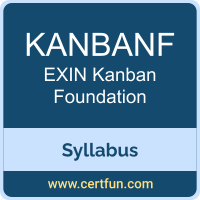 Use this quick start guide to collect all the information about EXIN KANBANF Certification exam. This study guide provides a list of objectives and resources that will help you prepare for items on the EXIN Kanban Foundation (KANBANF) exam. The Sample Questions will help you identify the type and difficulty level of the questions and the Practice Exams will make you familiar with the format and environment of an exam. You should refer this guide carefully before attempting your actual EXIN Kanban Foundation certification exam.
Use this quick start guide to collect all the information about EXIN KANBANF Certification exam. This study guide provides a list of objectives and resources that will help you prepare for items on the EXIN Kanban Foundation (KANBANF) exam. The Sample Questions will help you identify the type and difficulty level of the questions and the Practice Exams will make you familiar with the format and environment of an exam. You should refer this guide carefully before attempting your actual EXIN Kanban Foundation certification exam.
The EXIN KANBANF certification is mainly targeted to those candidates who want to build their career in Kanban domain. The EXIN Kanban Foundation exam verifies that the candidate possesses the fundamental knowledge and proven skills in the area of EXIN KANBANF.
EXIN KANBANF Exam Summary:
| Exam Name | EXIN Kanban Foundation |
| Exam Code | KANBANF |
| Exam Price | $268 (USD) |
| Duration | 60 mins |
| Number of Questions | 40 |
| Passing Score | 65% |
| Books / Training |
Why Get Certified? How to get certified |
| Schedule Exam | EXIN |
| Sample Questions | EXIN KANBANF Sample Questions |
| Practice Exam | EXIN KANBANF Certification Practice Exam |
EXIN KANBANF Exam Syllabus Topics:
| Topic | Details | Weights |
|---|---|---|
Benefits of Kanban - 12.5% |
||
| Adaptability of Kanban |
The candidate can… - explain how Kanban can be adapted to fit many situations. - explain why no two Kanban systems are the same. - explain how kaizen culture increases business value more than any individual practice. |
7.5% |
| Kanban culture |
The candidate can… - recognize a high-trust culture in a scenario. - explain why Kanban cannot exist without cultural change. |
5% |
Continuous improvement - 32.5% |
||
| Introducing kaizen |
The candidate can… - explain why the essence of starting with Kanban is to change as little as possible. - explain the concept of kaizen culture as a fundament for continuous improvement. - explain how Kanban is used as an incremental method of change to reach continuous improvement in the organization. - explain why it is difficult to achieve a true kaizen culture. - identify if an organization has implemented all elements of kaizen culture in a scenario. |
12.5% |
| Visualizing and improving the process |
The candidate can… - explain how mapping the workflow works. - explain why it is important to map the actual process followed and not the process that was agreed. - explain why it is important to make policies explicit. - explain which metrics can be used to show performance and improvement. - explain the benefit of thinking of any process as a set of policies. |
12.5% |
| Requirements for change |
The candidate can… - explain the relationship between slack and continuous improvement. - identify opportunities for continuous improvement in a scenario. - discuss the usefulness of daily stand-up meetings, after meetings, and operations reviews. |
7.5% |
Implementing Kanban - 50% |
||
| Visualizing the work |
The candidate can… - explain why it is important to track the workflow visually. - explain how to manage and track issues. - explain the process of drawing a card wall. - explain the use of swim lanes on a task board. |
10% |
| Creating work item cards |
The candidate can… - explain which information must be present on or with a work item card. - explain why it is useful to define work item types. - explain the importance of distinguishing different work item types. |
10% |
| Limiting work-in-progress (WIP) |
- The candidate can… - explain how limiting work-in-progress (WIP) shortens lead times in a scenario. - explain how to set work-in-progress limits (WIP-limits). |
5% |
| Managing flow and cadence |
The candidate can… - explain the meaning of the concept of cadence. - explain when it makes sense to make on-demand or ad hoc deliveries. - explain what allocating capacity according to demand means. - identify a bottleneck and the best solution to the problem using the five focusing steps from the theory of constraints (ToC) in a scenario. |
7.5% |
| Prioritization |
The candidate can… - explain the cadence and usefulness of queue replenishment meetings and release planning meetings. - identify the usefulness of backlog purge policies and an input cadence in a scenario. - explain how to use service level agreements (SLAs) with the help of classes of service. |
10% |
| Reducing variability |
The candidate can… - explain why to establish a delivery cadence. - identify internal sources of variability in a scenario. - identify external sources of variability in a scenario. |
7.5% |
Scaling Kanban - 5% |
||
| Kanban with distributed teams |
The candidate can… - explain how to deal with working from home and geographically distributed teams. |
2.5% |
| Kanban in large projects |
The candidate can… - explain how to scale Kanban to larger projects. |
2.5% |
To ensure success in EXIN KANBANF certification exam, we recommend authorized training course, practice test and hands-on experience to prepare for EXIN Kanban Foundation (KANBANF) exam.
